Lighting for seedlings can be a complicated and intimidating topic, but it doesn’t have to be. Once you learn about when and how to use them, you’ll find that it’s much easier than you think.
Don’t worry, I’m not going to get super technical on you here, I want to make this very easy. Below I will break it all down so you don’t get overwhelmed.
In this post, you’ll learn everything you need to know about using grow lights for seedlings. Including whether or not you need them, the best types to use, when to turn them on and for how long, how set them on an automated schedule, and much more.
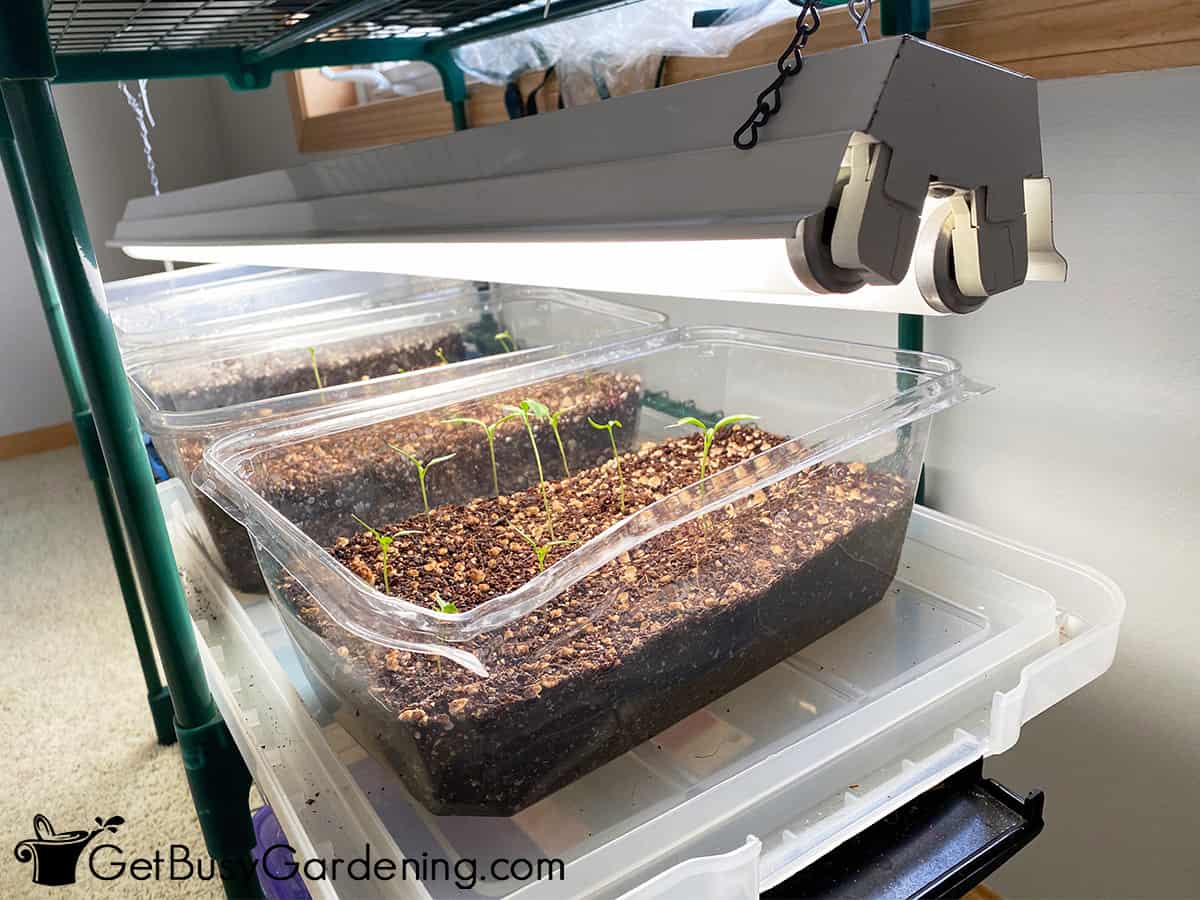
Why Use Artificial Light For Seedlings?
Adequate lighting is a key part of successful seedling care, and it will help give them a good start to life. When they don’t get enough, they become tall, weak, and leggy, and may not survive for very long.
I’ve been growing seeds indoors for well over 20 years, and I’ve learned why this is so important from trial and error.
My Story
I didn’t use grow lights on my seedlings for the first few years because I have a large south-facing window in my spare bedroom. I set up shelves right in front of it, and that worked ok. But my seedlings were always thin and looked unhealthy compared to the ones I saw at the store.
Things got worse for me once I started to experiment with different types of seeds, and some would stretch so far towards the window that I had no choice but to toss them out.
That’s when I realized I was wasting a lot of time and money (and heartache) just to save a few bucks. So I decided to buy myself some grow lights, and I was amazed at what a difference it made. I was sold!
Not only did my seedlings look fantastic, but supplementing with artificial lights meant I didn’t need to plant as many seeds. That’s because they were much healthier and stronger, I never had to throw any of them into the trash again.
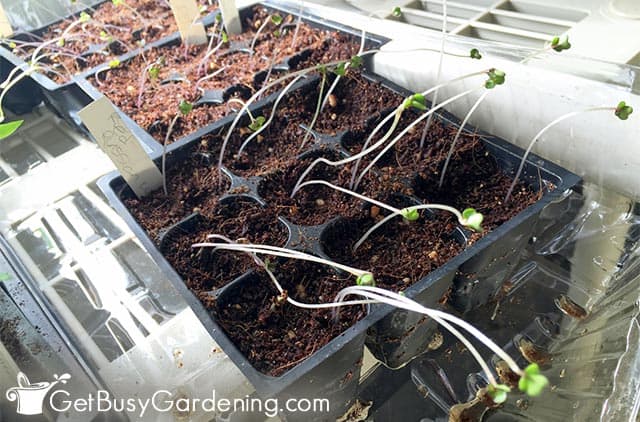
Do Seedlings Need Grow Lights?
The short answer to this questions is yes. Seedlings need artificial light indoors to grow as strong and healthy as possible, and it’s important to provide it right from the start. That being said, you don’t absolutely need to buy them.
If you’re a beginner, and you don’t want to invest the money up front, you can use a sunny window. Or better yet, if your home has a porch, patio, or another space that’s filled with natural sunlight, then try that and see how well it works for you.
But once you have a few flats going, and you know you’re in it for the long haul, I definitely recommend investing in proper lighting for your seedlings. They’ll end up paying for themselves in a short time.

Benefits
There are tons of benefits to using the proper lighting for seedlings. Below I’ve listed the main ones, so you can see why it’s so important:
- Stronger and healthier seedlings – The main benefit of using artificial lights is that your seedlings will be much stronger, healthier, and stay more compact than they would in a sunny window.
- Better survival rate – Once you provide enough light, you’ll find that the survival rate of your seedlings is much higher, and you’ll be so much happier with the outcome.
- Less waste – Since you won’t have to plant extras to make up for those losses, there will be much less waste. You won’t waste any seeds or dirt… or your time. Because of this, you’ll find the lights will pay for themselves pretty quickly.
- Much easier – Getting them on an automated schedule will make your life so much easier too. By using a timer, you can just set it and forget it, rather than having to constantly monitor and rotate your trays.
- Prevents legginess – Providing adequate lighting is the only way to prevent seedlings from getting tall and leggy.
- Grow seeds anywhere in your house – Since you won’t have to worry about keeping them in a room that gets tons of natural sunlight, you can grow your seedlings anywhere in the house.
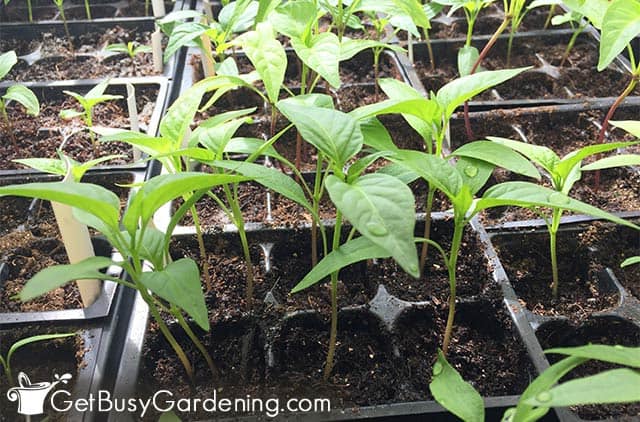
Best Grow Lights For Seedlings
It’s very important to make sure that you use the right kind of grow lights for your seedlings. Some types, like regular incandescents, for example, are way too hot, and will only end up frying the tiny starts. Here are the best ones to use:
- Plant grow bulbs – Your first option, which also tends to be the cheapest, is to buy plant grow bulbs. You can find them for sale just about anywhere these days. They come in standard sizes that are made to fit into any fixture that you already have.
- Fluorescents – Another great option is to use standard cool-white fluorescent bulbs. I made my own seedling grow lights using a standard shop fixture and fluorescent bulbs. Get the step by step instructions here.
- LED grow lights – If you don’t want to mess around with assembling your own, or you’re not sure how or where to hang them, then I recommend getting a full system like this 4′ LED setup. Or something smaller like this one that’s 2′ long.
- T5 grow lights – Another great option is T5 grow lights. Here’s a 2′ long one that I recommend, otherwise that same one also comes in an 18″ length if you need something longer.

How Much Light Do Seedlings Need?
Understanding how much light seedlings require is just as important as choosing the right bulbs. So in this section, I’ll tell you exactly how many hours they need, and give you examples of the best schedule to keep them on.
Number Of Hours
Seedlings need 12-16 hours of light every single day, without fail. The reason this is a broad range is that some types need more than others do.
If you’re new to this, I recommend you start by keeping them on for 14 hours a day. Then monitor your seedlings closely. If they start getting tall, stretching, or growing sideways, bump it up to 16 hours per day.
On the other hand, if they are staying compact and thick, then you can turn it down to 12 hours to save some energy, and see how well they do with less light.
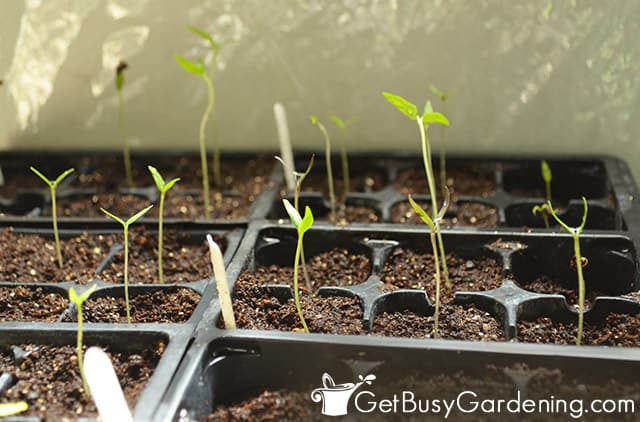
Best Lighting Schedule To Use
It’s important to stick to a strict schedule – consistency is important for uniform growth. So I highly recommend using an inexpensive outlet timer to keep it the same every day.
Some people like to follow a 12/12 lighting cycle for their seedlings. That means the bulbs stay on for 12 hours during the day, and they are off for 12 hours at night.
But in my experience, that’s not long enough, so I prefer running mine for 14-16 hours daily. I set my timer on a schedule to turn them on at 6:00am every morning, and to turn them off at 10:00pm each night.
If for some reason that doesn’t work for you, you could do a 7am to 9pm schedule, or something similar. The exact times don’t matter so much, as long as the schedule stays the same.
When Do I Put My Seedlings Under Light?
You should put your seedlings under light as soon as the first one germinates (starts to sprout). They grow very fast, and will begin stretching right away – even as they’re still emerging.
It’s important to note that some types of seeds need light to germinate. So, if that’s the case with any of yours, then you should put them under there right after you plant them.
Related Post: How To Fix Common Seedling Problems
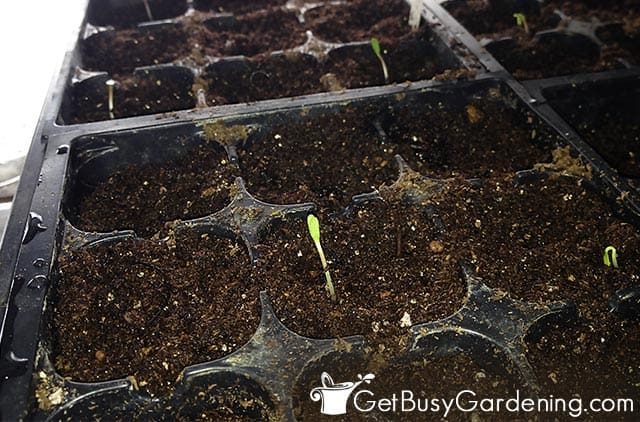
How High To Hang The Lights
To be effective, the grow lights need to be fairly close to your seedlings. You should keep them 2-3″ above the tops of the leaves at all times. If yours have an adjustable intensity setting, you can turn that up and move the fixture higher (6-12″ above, depending on how strong the intensity is).
You’ll need to adjust the height on a regular basis as your starts get taller. The leaves should never touch the bulbs, or they could burn.
So make sure to check on them every day, and move the lights up as necessary. Using an adjustable hanger will make this job a whole lot easier.
If you need them for germination, or the lids are still on your trays, then hang them directly above (but never touching) the plastic.
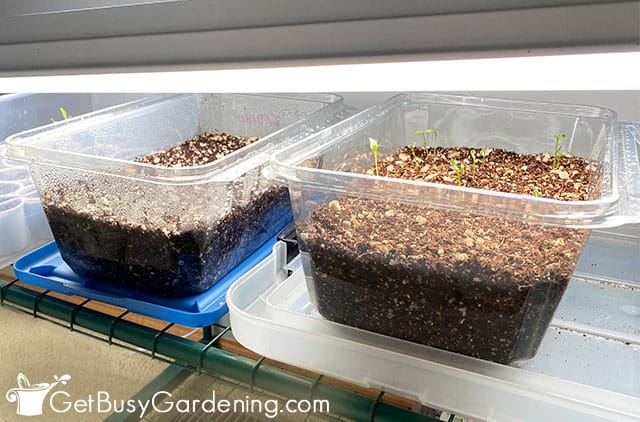
When To Turn Off Your Grow Lights
As long as your seedlings are indoors, they should be under the grow lights. The only time you should remove them or turn them off is when you put your seedlings outside.
Once you begin to harden your seedlings, you can turn off the lights while they are outdoors. But, you should always put them back right away whenever you bring them inside, or they will quickly start getting leggy.
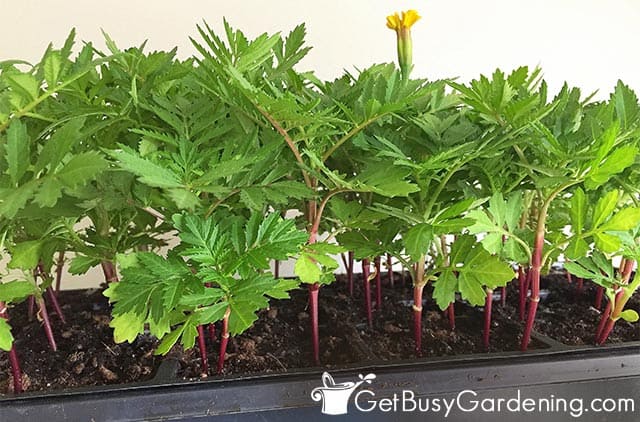
FAQs
No, and you should not put seedlings under grow lights for 24 hours a day. It’s important to follow the normal pattern of the sun, or your seedlings will suffer when it’s time to move them outside. Just like us, they need darkness at night to rest. So keep them on during the day, and turn them off at night.
If you provide the proper lighting for seedlings, then you should not need to rotate them. However, many times the trays are wider than the lamp fixture. So, you may notice some of the ones around the outside edges will start reaching. In that case, it’s best to rotate them daily to ensure even growth.
Yes, you certainly could try starting your seeds indoors without grow lights. However, most homes do not get enough sun for healthy seedling development. So, for the best results, I recommend supplementing with artificial ones.
Some types of seeds do need light to germinate, but others do not. Always check the packet for details, or research the specific varieties before planting them.
Adequate lighting is extremely important for success with seedlings, and it will give them a healthy start to life. Plus you’ll find that it makes your job much easier, with less waste and frustration.
If you’re new to starting seeds, and you want to learn everything you need know in order grow your garden from seed, then you should enroll in my Online Seed Starting Course. This self-paced course will walk you through it all, step by step. Enroll and get started right now!
Otherwise, if you just need a refresher, or you want a quick-start guide, then my Starting Seeds Indoors eBook is just what you need.
More Posts About Seedlings
Share your tips about using artificial lighting for seedlings in the comments below.
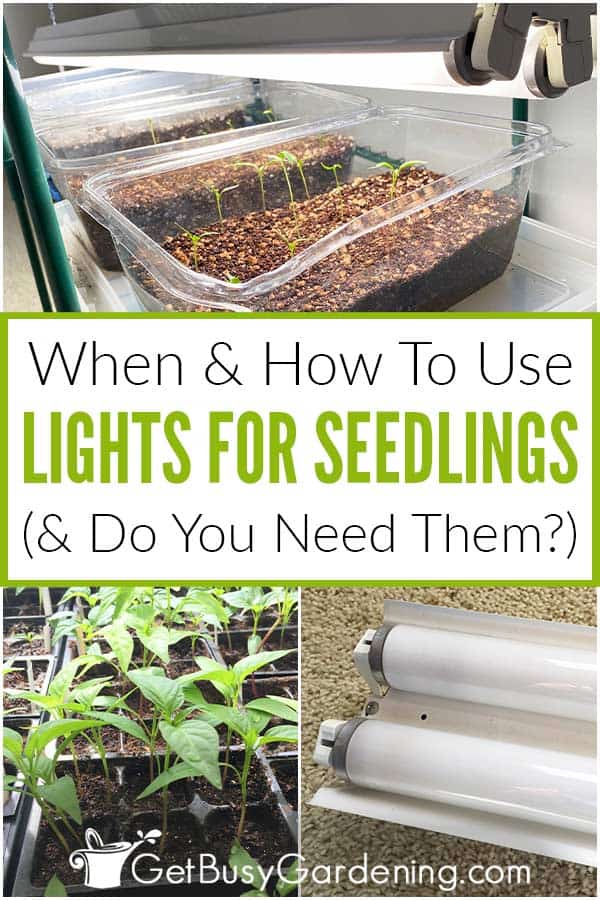

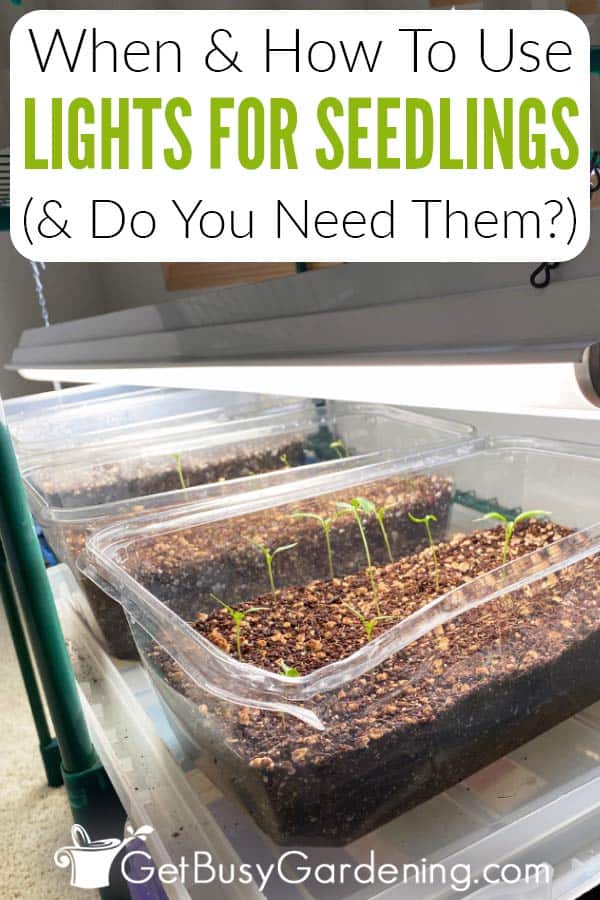



Timothy Reed says
Hi
I have 1000w grow light, I also have a light gauge that goes from 0-1000 I’ve read that 500 is a good intensity is that true.
Amy Andrychowicz says
Yes, 500 PAR would be the minimum for seedlings. I recommend giving them between 700-1000, and see how well they do. If you prefer to start at the lower level, then closely monitor your seedlings to make sure they aren’t getting leggy. If they start reaching for the light, then raise the PAR level.
Mario says
My seedling are getting long and thin. I have to support the seedling. Based on your reading I need more time with the grow light. When do you use red, blue or both grow light? Ty
Amy Andrychowicz says
Yes, if the seedlings are getting tall and thin, then they definitely need more light. I recommend keeping the grow lights on for 14-16 hours per day. The section above titled “How To Use Grow Lights For Seedlings” will help answer more of your questions.
Evelyn says
I’ve read that LED lights need to be farther away from seedlings due to the intensity. How far should they be from seedlings if I have a 100 watt-equivalent square LED?
Amy Andrychowicz says
While it’s true that some lights are much more intense than others, LED lights don’t put off much heat, so there is less risk of burning seedlings. But there are so many different brands of grow bulbs out there that it is difficult to tell you exactly how far away from you seedlings to hang the one that you have. I always start by hanging mine about 4-5″ above my seed trays. Then I adjust the height as the seedlings grow, depending on how well they are reacting to it. The best thing to do is to start high (4-6″), then check on your seedlings a few times per day. If they are starting to reach for the light, then move it a few inches closer. I would also recommend you check with the manufacturer of your lights to see if you can find instructions/recommendations for that specific brand. Good luck!
Linda Wilton says
Some of my healthy seedlings are getting taller and taller, now getting too close to the grow lights. The lights are as high as they can go? Is it ok to put them in a south facing window now? Or what other ideas?
Amy Andrychowicz says
If it’s warm enough, I would start hardening them off and getting them ready to move out to the garden. When they get that tall, it means they are ready to go outside. If it’s not warm enough yet, then I would figure out how to hang your grow lights higher, perhaps you can put your stand up on some blocks or books to make it taller? Then next year, plan to start those seeds a little later, so they don’t get so large before it’s time to move them outside. You certainly could try putting them into a sunny window, some seedlings will do fine. However, as long as they are inside, they will do best under artificial lights. Otherwise, they tend to start getting leggy pretty quickly. Hope this helps.
amy martinez says
can you use a grow light in a shop light fixture?
Amy Andrychowicz says
Yes! Here’s how to make your own DIY grow lights for seedings.
Hinya De Pena says
when in the process of the seedling do you remove the humidity dome and the plastic from the greenhouse?
Amy Andrychowicz says
You can remove the plastic dome once the seedlings have grown tall enough to touch the inside of the lid, or have their first few sets of true leaves.
Gail says
Are grow lights needed everyday (even when they are 5-6″ tall) until I transplant them out into my garden? Or can I just place them in a sunny window at this stage of their growth?
Amy Andrychowicz says
Yes, as long as your seedlings are indoors, then you should keep the grow lights on every day.
Anna says
I purchased a grow light with LED light efficiency of 30W, LED quantity of 60 PCS. It has 6 different levels of brightness, would you recommend using a low or high intensity? I began with low, but I’m not sure whats better for leggy plants!
Amy Andrychowicz says
Humm.. I’m not exactly sure, I’m not familiar with those particular grow lights. If they didn’t come with instructions, then I would personally start somewhere in the middle, and then keep a close eye on the seedlings. If the seedlings look like they are reaching for the light after a day or two, then I would turn the grow lights up a few notches. If any of the leaves turn brown, then turn it down right away. If the seedlings look good after a few days, then you could either keep the light the same, or turn it up a little. I would just worry that the highest setting may end up burning tender seedlings.
Anna Kuzma says
Thanks so much! The seedlings have been taking well to the highest power setting, I’ve discovered the light’s not too strong and works well in my case.
Amy Andrychowicz says
Perfect! Thanks for sharing your results, glad to hear your new seedlings lights are working well for you. 🙂
Cindy says
My husband built me a hoop house last year. I have my seeds planted under grow lights in my house but can I move them to the hoop house during the day? My hoop house isn’t heated but in the day I’m hitting 70-90 degrees now or do they need to stay under the lights for a few weeks?
Amy Andrychowicz says
Yes, you can move your seedlings out to your hoop house during the day, as long as it’s warm enough for them. They don’t need to be under lights. However, just make sure they aren’t in direct sunlight, or it could burn their leaves. Also, make sure it doesn’t get too hot in there during the day, or it could cook them (I would vent it if it’s going to get above 90F). Read my post about how to harden seedlings to learn more about the process of getting them used to living outside.
Jacob says
Hi,
Will I need another type of light bulb to have it on over night to keep the soil temperature around 80F?
Amy Andrychowicz says
I would not recommend keeping the grow lights on your seedlings all night long. It’s better for them if you give them some darkness at night, like they will get once they go outside. If you need to keep them warm overnight, then you could either run a space heater in the room, or place them on heat mats.
Jim Jozwiak says
I got the world’s cheapest LED grow light, with three light wands of red/blue LEDs.
I aimed it at about a square foot of seedlings for 24 hours a day, got very beautiful baby plants, but when I transplanted them outside, they quickly got little white spots on the leaves that I diagnosed as light burn.
I theorized that plant, although beautifully formed, lacked industrial-strength chloroplasts that could withstand the sun. In other words, the total daily radiation dose was right, but the radiation strength was too little.
So, I got another identical cheap grow light and only run both units 12 hours. I also added aluminum foil around the box of seedlings to get as much light intensity as possible. The lights are 6 inches above the soil. I transplant when roots start to come out of the bottom of the plant because if I transplant earlier, a couple of really hot days will badly damage the plant.
Amy Andrychowicz says
Awesome! Thanks so much for sharing your experience with using different types of light for your seedlings! Great information. I recommend hardening your seedlings before transplanting them into the garden. They can easily burn in the intense sunlight no matter how strong your grow lights are.
Sarah says
I definitely agree the culprit is likely not enough hardening off, weaning the plants to natural light.
I used to over winter a hibiscus in our basement by the windows where it only got enough light to survive the winter. Because the darn thing was so heavy I couldn’t gradually introduce it back to natural light. As a result, the leaves got the exact same white spots that Jim has described.
Paul says
So to make sure I read this correctly, you are using just regular fluorescent bulbs? No true grow lights?
Amy Andrychowicz says
You can use either regular fluorescent bulbs or grow light bulbs for seedlings.
Janet says
Hello
I started my plants a bit late this year and they are small. I do have a green house and can move them into there. But should I continue using the grow lights? If so, how long would I continue to do this? Is there a specific height? Thank you
Amy Andrychowicz says
If they will get full sun all day long in your greenhouse, then you can move your seedlings out there and stop using the grow lights. Once the seedlings have grown a few sets of their true leaves, you can start hardening them off outside to prepare them for the transition to the garden.
Alena Inman says
so my heat lamp broke today and i put my led light up is that okay i have auto flowering seeds is the led light going to effect my plant to where it dies??
Amy Andrychowicz says
LED lights don’t give off much heat, so you don’t have to worry about them getting too hot and killing your seedlings. However, if you are looking for something to replace your heat lamp, then LED lights aren’t going to help. I recommend using a seed starting heat mat.
Debbie says
Is a 2ft. 1 light tube suitable for seed growing in the same indoor greenhouse like yours
( like I have also ) would that be enough light??
Amy Andrychowicz says
It depends on how many seedlings you have growing in your little greenhouse. I use a 2ft light with two tubes hanging above each shelf of my greenhouse, and when it’s really full of seedlings, I still need to rotate them to be sure they’re all getting enough light. A light with only one bulb in it probably won’t be enough if you have lots of seedlings growing on each shelf.
phil beere says
While thr light is bright fleuros dont create heat??
Amy Andrychowicz says
They will create some warmth, but will not get hot and fry the seedlings like regular incandescent light bulbs can.
Marie says
These are great ideas for choosing indoor lighting to start your seeds. I’ve never started my own (I’ve always bought the plants at the local nursery) but this would be a great way to delve into starting my own seedlings. Thanks for all the information!
Amy Andrychowicz says
You’re welcome!
william says
What about temperature of room or soil??
thanks William
Laura Bainbridge says
William,
For temperature generally you want around 70 degrees F. No more than 75 but not under 70 I’ve found optimal